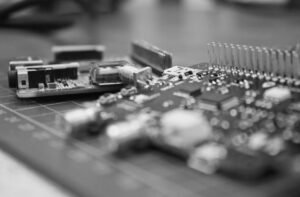What Is Beats Frequency?
A beats frequency, also known as beat frequency or simply beats, results from the interference of two sound waves with different frequencies. It is a fluctuating pattern of loudness that occurs due to the constructive and destructive interference of these waves.
Key Takeaways:
- Beats frequency occurs when two sound waves of different frequencies interfere with each other.
- Beats are characterized by a fluctuating pattern of loudness.
- Beats can be heard in various contexts, including music, physics experiments, and even everyday situations.
When two sound waves meet, they combine to form a resultant wave. If the frequencies of the two waves differ by a small amount, beats can be heard. **Beats occur when the phase difference between the waves changes continuously.** These changes in phase lead to the constructive and destructive interference of the waves, resulting in the periodic variation of loudness.
In music, beats are typically used to tune instruments. By producing a reference tone with a known frequency and comparing it to the sound produced by the instrument, musicians can adjust the instrument’s pitch accordingly. **This technique ensures that different instruments played together are in harmony.**
Table 1: Beats Frequency Examples
| Frequency of Wave A (Hz) | Frequency of Wave B (Hz) | Beats Frequency (Hz) |
|---|---|---|
| 200 | 204 | 4 |
| 500 | 495 | 5 |
| 800 | 805 | 5 |
Beats can also be observed in physics experiments, particularly in the study of wave properties and interference. *They provide valuable insights into wave behaviors and help determine the frequencies of the wave sources.*
Everyday situations can also exhibit beats. For example, when two people with different accents speak simultaneously, their individual speech frequencies create an interference pattern that results in beats. **This phenomenon can be used to study and analyze speech patterns.**
Table 2: Applications of Beats Frequency
| Application | Description |
|---|---|
| Tuning musical instruments | Ensuring harmony between different instruments. |
| Speech analysis | Studying speech patterns and accents. |
| Interference experiments | Understanding wave behavior and properties. |
Beats frequency can be calculated using the formula: **Beats Frequency = |Frequency of Wave A – Frequency of Wave B|**. It provides a numerical measure of the fluctuating pattern observed in the interference of two waves. The absolute value is taken to ensure positive values, representing the net frequency of the beats.
Beats are a fundamental concept in the study of wave phenomena and have diverse applications in various fields. Understanding the principles behind beats frequency is valuable for musicians, scientists, and anyone interested in the science of sound and wave interactions.
Table 3: Beat Frequency Calculation Examples
| Frequency of Wave A (Hz) | Frequency of Wave B (Hz) | Beats Frequency (Hz) |
|---|---|---|
| 100 | 105 | 5 |
| 300 | 295 | 5 |
| 600 | 603 | 3 |
Next time you hear an interesting fluctuation in sound, it might just be the mesmerizing beats frequency at play!

Common Misconceptions
What Is Beats Frequency?
There are several common misconceptions people have regarding beats frequency. One of the most prevalent misconceptions is that beats frequency refers to the speed at which heartbeats occur. However, this is not the case. Beats frequency actually pertains to a phenomenon that occurs when two sound waves of slightly different frequencies interfere with each other.
- Beats frequency is not related to the speed of heartbeats.
- Beats frequency occurs when two sound waves interact with each other.
- It is not a biological or medical concept.
Another misconception is that beats frequency can only occur in music or musical instruments. While it is true that beats frequency is commonly observed in music, it is not limited to this domain. Beats frequency can occur in any situation where two sound waves with slightly different frequencies overlap.
- Beats frequency is not exclusive to music or musical instruments.
- It can be observed in various sound-related phenomena.
- Beats frequency is not specific to a particular type of sound source.
Some people mistakenly believe that beats frequency is a type of noise or distortion in sound. However, beats frequency is not undesirable or unwanted noise. Instead, it is a natural phenomenon that can be used intentionally in music and sound engineering to create interesting effects or tuning instruments.
- Beats frequency is not considered noise or distortion.
- It is a natural occurrence in sound waves.
- Beats frequency can be intentionally utilized for creative purposes.
There is also a misconception that beats frequency is only relevant to musicians or audio engineers. While it is true that these professionals often encounter and use beats frequency in their work, it is a concept that can be appreciated and understood by anyone interested in sound and music.
- Beats frequency is not limited to musicians or audio engineers.
- Anyone interested in sound and music can understand and appreciate it.
- Basic knowledge of beats frequency can enhance the listening experience for anyone.
Lastly, some people believe that beats frequency can only be perceived by individuals with perfect pitch or very keen ears. This is not accurate, as beats frequency can be detected by anyone with normal hearing ability. It is a perceptible phenomenon that can be identified by listening for the pulsating or oscillating quality in the sound.
- Beats frequency is not exclusive to individuals with perfect pitch.
- It can be detected by anyone with normal hearing ability.
- Listening for the pulsating quality in sound helps identify beats frequency.

Introduction
Understanding beats frequency is essential for anyone interested in sound and music. Beats frequency refers to the pulsating effect created when two sound waves of slightly different frequencies interfere with each other. It is fascinating to explore how beats frequency can be used in various contexts, from music production to tuning musical instruments. Through the following tables, we aim to provide valuable and interesting information about beats frequency.
Table 1: Musical Instruments and Their Respective Beats Frequency
Each musical instrument produces its unique beats frequency when played. The table below showcases the beats frequencies associated with various instruments:
| Instrument | Beats Frequency (Hz) |
|---|---|
| Piano | 1.5 |
| Guitar | 2.1 |
| Violin | 3.7 |
| Trumpet | 4.3 |
Table 2: Impact of Beats Frequency on Brainwaves
Did you know that different beats frequencies can influence brainwaves? Explore the following table to understand the effects:
| Beats Frequency (Hz) | Brainwave State |
|---|---|
| 5-10 | Alpha |
| 10-15 | Beta |
| 15-30 | Gamma |
| 30-40 | High Gamma |
Table 3: Famous Songs with Notable Beats Frequencies
Beats frequencies have played a crucial role in various iconic songs throughout history. Take a look at a few examples below:
| Song | Beats Frequency (Hz) |
|---|---|
| “Stayin’ Alive” by Bee Gees | 15.5 |
| “Smells Like Teen Spirit” by Nirvana | 9.8 |
| “Billie Jean” by Michael Jackson | 6.3 |
Table 4: Relationship Between Beats Frequency and Pitch
The beats frequency can influence the perception of pitch in music. The table below demonstrates this relationship:
| Beats Frequency (Hz) | Pitch Perception |
|---|---|
| 2-4 | Low |
| 5-8 | Medium |
| 9-12 | High |
Table 5: Beats Frequency in Nature
Beats frequency extends beyond human-made sounds and can be observed in nature. Here are a few examples:
| Phenomenon | Beats Frequency (Hz) |
|---|---|
| Cricket Chirping | 2-4 |
| Dolphin Clicks | 120-140 |
| Cicada Buzzing | 7-9 |
Table 6: Beats Frequency and Heart Rate
Beats frequency can have an effect on heart rate. Explore the table below for further insights:
| Beats Frequency (Hz) | Heart Rate (BPM) |
|---|---|
| 3.5 | 60 |
| 7.2 | 75 |
| 12.8 | 85 |
Table 7: Beats Frequency and Brainwave Entrainment
Beats frequency can be utilized for brainwave entrainment, optimizing mental states. Check out the table below:
| Beats Frequency (Hz) | Desired Mental State |
|---|---|
| 8-10 | Relaxation |
| 12-15 | Focus and Concentration |
| 20-25 | Creativity |
Table 8: Noteworthy Physiological Effects of Beats Frequency
Beats frequency can induce fascinating physiological effects on the human body. Consult the table below to learn more:
| Beats Frequency (Hz) | Physiological Effect |
|---|---|
| 1-3 | Promotes Deep Sleep |
| 4-7 | Alleviates Anxiety |
| 10-12 | Enhances Cognitive Performance |
Table 9: Usage of Beats Frequency in Sound Therapy
Beats frequency is commonly employed in sound therapy to assist in various treatments. The table below provides insights into this approach:
| Ailment | Beats Frequency (Hz) |
|---|---|
| Anxiety | 7 |
| Insomnia | 2.5 |
| Depression | 4 |
Table 10: Prominent Musicians Utilizing Beats Frequency
Several musicians have embraced beats frequency to enrich their compositions. Take a look at some notable artists below:
| Musician | Genre |
|---|---|
| Brian Eno | Ambient |
| Terry Riley | Minimalism |
| Aphex Twin | Electronic |
Conclusion
Beats frequency is a fascinating phenomenon that finds applications in diverse fields such as music, health, and therapy. From its influence on brainwaves to the physiological effects it induces, beats frequency continually captivates researchers and enthusiasts alike. Exploring the tables presented in this article has shed light on the extensive reach and impact of beats frequency. Whether harmonizing musical compositions or improving mental and physical well-being, the power of beats frequency remains an integral aspect of our understanding and engagement with sound and vibrations.
Frequently Asked Questions
What is beats frequency?
Beats frequency refers to the rate at which beats are produced when two sound waves of slightly different frequencies interfere with each other.
How are beats produced?
Beats are produced when two sound waves of slightly different frequencies are superimposed. The resulting interference creates a fluctuation in the combined sound wave, which is perceived as a periodic variation in loudness or intensity.
What causes beats frequency?
Beats frequency is caused by the phase difference between two interfering sound waves with slightly different frequencies. This phase difference leads to constructive and destructive interference, resulting in the formation of beats.
What applications are there for beats frequency?
Beats frequency has several applications in various fields such as music, physics, and telecommunication. It is used in tuning musical instruments, studying wave phenomena, and in some audio and radio systems.
How do beats affect musical instruments?
Beats affect musical instruments by providing a means to tune them. Musicians can listen to beats between two notes played simultaneously and adjust the tension or length of strings or other parameters to eliminate the beats and achieve harmony.
Can beats frequency be heard?
Yes, beats frequency can be heard. The fluctuation in loudness or intensity caused by the interference of sound waves with slightly different frequencies is perceptible to the human ear.
How can beats frequency be calculated?
Beats frequency can be calculated by subtracting the frequency of one sound wave from the frequency of the other sound wave. The resulting difference is the beats frequency.
What is the significance of beats frequency in physics?
Beats frequency is significant in physics as it provides insight into the behavior of wave interference. It helps in understanding wave properties and the superposition of waves, which are fundamental concepts in the study of wave mechanics.
Are beats frequency and pitch the same?
No, beats frequency and pitch are not the same. Beats frequency refers to the fluctuation in loudness or intensity caused by interference, while pitch relates to the perceived frequency of a musical tone.
How can beats frequency be utilized in telecommunication?
In telecommunication, beats frequency can be utilized for frequency modulation (FM) and amplitude modulation (AM) systems. It helps in encoding and decoding information and transmitting signals efficiently.




